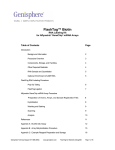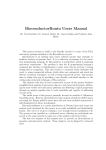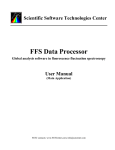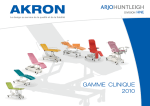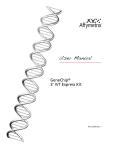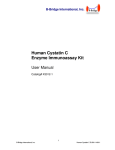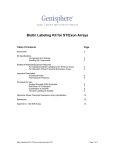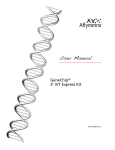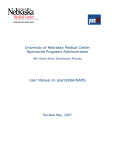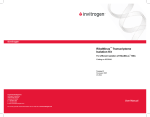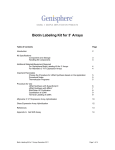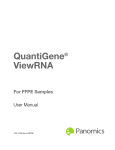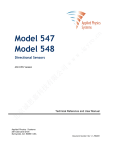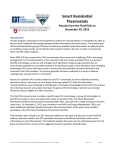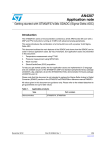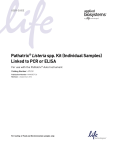Download FlashTag® Biotin HSR
Transcript
FlashTag® Biotin HSR RNA Labeling Kit for Affymetrix® GeneChip® miRNA Arrays Table of Contents Page Introduction Background Information 2 Procedure Overview 3 Components, Storage, and Handling 4 Other Required Materials 4 RNA Sample and Quantitation 5 FlashTag Biotin HSR RNA Labeling Procedure Poly (A) Tailing 6 FlashTag Biotin HSR Ligation 7 Affymetrix GeneChip miRNA Array Procedure Preparation of Ovens, Arrays, and Sample Registration Files 8 Hybridization 8 Washing and Staining 9 Scanning 9 Analysis 10 References 12 Appendix A: ELOSA QC Assay 13 Appendix B: Array Rehybridization Procedure 16 Appendix C: Example Reagent Preparation and Storage 17 Genisphere Technical Support: 877.888.3DNA www.genisphere.com FlashTag HSR Feb2011 Page 1 of 17 Introduction Background Information The FlashTag Biotin HSR kit will label any RNA sample, including total RNA, severely degraded RNA, plant RNA, and low molecular weight RNA. This protocol describes labeling total RNA or low molecular weight (LMW) RNA for analysis by Affymetrix GeneChip miRNA Arrays with an in-process ELOSA QC Assay. LMW RNA molecules (snRNA, hnRNA, piRNA, miRNA, etc.) have recently been shown to be involved in important biological processes such as mRNA degradation, transcriptional gene silencing (TGS) and translational repression.1-8 As a result, these newly discovered biomolecules are gaining the interest of the scientific community as possible new drug targets and for use in diagnostics. FlashTag Biotin HSR provides the necessary tools to identify such targets. FlashTag Biotin HSR labeling is fast, simple, accurate, highly sensitive and reproducible. Starting with 1001000ng of total RNA, the process begins with a brief tailing reaction followed by ligation of the biotinylated signal molecule to the target RNA sample (see page 3). The labeling process is complete in less than one hour. The high sensitivity of FlashTag Biotin HSR is due to Genisphere’s proprietary 3DNA® dendrimer signal amplification technology. The 3DNA dendrimer is a branched structure of single and double stranded DNA conjugated with numerous labels.9-10 The 3DNA molecule in the FlashTag Biotin HSR kit provides ultrasensitive biotin labeling. Please review this product manual before beginning experiments. Materials needed for Affymetrix GeneChip miRNA Arrays are listed on page 4. Materials needed for the ELOSA QC Assay are listed in Appendix A. Note that ELOSA wells must be coated with DNA Spotting Oligos and incubated overnight before the ELOSA assay may be run. Genisphere Technical Support: 877.888.3DNA www.genisphere.com FlashTag HSR Feb2011 Page 2 of 17 Genisphere Technical Support: 877.888.3DNA www.genisphere.com FlashTag HSR Feb2011 Page 3 of 17 Components, Storage, and Handling FlashTag Biotin HSR RNA Labeling Kit: Store all components at –20°C Vial 1 Vial 2 Vial 3 Vial 4 Vial 5 Vial 6 Vial 7 Vial 8 Vial 9 Vial 10 Vial 11 Vial 12 10X Reaction Buffer 25mM MnCl2 ATP Mix PAP Enzyme 5X FlashTag Biotin HSR Ligation Mix T4 DNA Ligase HSR Stop Solution RNA Spike Control Oligos ELOSA Spotting Oligos ELOSA Positive Control Nuclease-Free Water 27.5% Formamide Handling Kit Contents Vials 1, 2, 5, 7, 9, 11 and 12: Thaw at room temperature, vortex, and briefly microfuge. Vials 3, 8 and 10: Thaw on ice, microfuge if necessary, and keep on ice at all times. Vials 4 and 6: Remove from freezer just prior to use, and briefly microfuge. Keep on ice at all times. Do not vortex. Other Required Materials (Refer to Appendix C for example reagent preparation and storage) All materials should be nuclease-free, and all reagents should be prepared with nuclease-free components. • • • • • RNA sample containing low molecular weight (LMW) RNA (see RNA Sample and Quantitation on page 5) Nuclease-free water (Applied Biosystems cat. no. AM9932 or equivalent) 1mM Tris (Appendix C) Reagents for analysis by Affymetrix GeneChip miRNA Array: • Affymetrix miRNA Array: GeneChip miRNA Array (Affymetrix cat. no. 901324, 901325, or 901326) GeneChip miRNA 2.0 Array (Affymetrix cat no. 901753, 901754, or 901755) • Affymetrix GeneChip Command Console® Software (AGCC) • GeneChip Eukaryotic Hybridization Control Kit (Affymetrix cat. no. 900454) If necessary, Control Oligonucleotide B2, 3nM (included in Hybridization Control Kit) can be ordered separately (Affymetrix cat. no. 900301) • GeneChip Fluidics Station 450 (Affymetrix cat. no. 00-0079) • GeneChip Hybridization, Wash and Stain Kit (Affymetrix cat. no. 900720) If necessary, Wash Buffer A (included in Hybridization, Wash and Stain Kit) can be ordered separately (Affymetrix cat. no. 900721) If necessary, Wash Buffer B (included in Hybridization, Wash and Stain Kit) can be ordered separately (Affymetrix cat. no. 900722) • Laser Tough-Spots® 3/8" diameter (Diversified Biotech cat. no. SPOT-1000) • Laser Tough-Spots® 1/2" diameter (Diversified Biotech cat. no. SPOT-2000) Reagents for ELOSA QC Assay: Refer to Appendix A and Appendix C. Genisphere Technical Support: 877.888.3DNA www.genisphere.com FlashTag HSR Feb2011 Page 4 of 17 RNA Sample and Quantitation Either Total RNA or LMW (Low Molecular Weight) RNA can be labeled with FlashTag Biotin HSR. Using total RNA can save time and money, and prevent sample loss.11,12 RNA Isolation Any kit for purification of total RNA or LMW RNA will be compatible with FlashTag Biotin HSR. Elute or resuspend the RNA in nuclease-free water. Ensure that the purification method retains low molecular weight species. Some commercial products that have been tested successfully with FlashTag Biotin HSR include: Applied Biosystems: mirVana™ miRNA Isolation Kit Applied Biosystems: RecoverAll™ Total Nucleic Acid Isolation Kit for FFPE Qiagen: miRNeasy Mini Kit Invitrogen: PureLink™ miRNA Isolation Kit Invitrogen: TRIzol® reagent (total RNA only) with additional overnight –20°C precipitation step during isopropanol precipitation13 Quantitation To accurately determine the concentration of the RNA sample, Genisphere recommends the use of the QuantiT™ RiboGreen RNA Assay Kit (Invitrogen cat. no. R11490) or the NanoDrop® ND-1000 Spectrophotometer (NanoDrop Technologies). RNA Input for FlashTag Biotin HSR The table below describes general recommendations for RNA input for FlashTag Biotin HSR labeling. The amount of microRNA relative to total RNA is less in cultured cells than in tissues. Therefore, Genisphere recommends using more RNA isolated from cultured cells. RNA Sample Input for FlashTag Biotin HSR Labeling Total RNA containing LMW RNA 100 - 1000ng total RNA from tissues 500 - 1000ng total RNA from cultured cells Enriched LMW RNA, quantitated 100 - 400ng LMW RNA from tissues 200 - 400ng LMW RNA from cultured cells Enriched LMW RNA, not quantitated Enriched from 100 - 1000ng total RNA Genisphere Technical Support: 877.888.3DNA www.genisphere.com FlashTag HSR Feb2011 Page 5 of 17 FlashTag Biotin HSR RNA Labeling Procedure Genisphere recommends running an ELOSA QC Assay to verify this labeling procedure prior to array hybridization. Refer to Appendix A. Note that ELOSA wells must be coated with DNA Spotting Oligos and incubated overnight before the ELOSA assay may be run, and that Plate Washing and Blocking steps may be completed prior to or during the FlashTag Biotin HSR labeling procedure. Poly (A) Tailing 1. Adjust the volume of RNA to 8µl with Nuclease-Free Water (Vial 11). 2. Transfer the 8µl RNA to ice. Add 2µl RNA Spike Control Oligos (Vial 8) and return to ice. 3. Dilute the ATP mix (Vial 3) in 1mM Tris as follows: For total RNA samples, dilute the ATP Mix 1:500. For enriched, quantitated samples, calculate the dilution factor according to the following formula: 5000 ÷ ng input LMW RNA Example: If using 100ng of enriched LMW RNA, the dilution factor is 5000 ÷ 100 = 50. Dilute the ATP Mix 1:50. For enriched samples that are not quantitated, calculate the dilution factor according to the following formula: 1000 ÷ µg input total RNA Example: If the sample was enriched from 500ng total RNA, the dilution factor is 1000 ÷ 0.5 = 2000. Dilute the ATP Mix 1:2000. 4. Add the following components to the 10µl RNA/Spike Control Oligos, for a volume of 15µl: 1.5µl 10X Reaction Buffer (Vial 1) 1.5µl 25mM MnCl2 (Vial 2) 1.0µl diluted ATP Mix (Vial 3 dilution from step 3) 1.0µl PAP Enzyme (Vial 4) Note: If at least 5 labeling reactions are simultaneously run, a master mix may be prepared at this step. Prepare one extra reaction’s worth of reagents. For example, when 5 samples are run, prepare a master mix for 6 samples: 9µl 10X Reaction Buffer (Vial 1) 9µl 25mM MnCl2 (Vial 2) 6µl diluted ATP Mix (Vial 3 dilution from step 3) 6µl PAP Enzyme (Vial 4) Add 5µl of master mix to the 10µl RNA/Spike Control Oligos, for a volume of 15µl. 5. Mix gently (do not vortex) and microfuge. 6. Incubate in a 37oC heat block for 15 minutes. Discard any unused, diluted ATP Mix from step 2. Genisphere Technical Support: 877.888.3DNA www.genisphere.com FlashTag HSR Feb2011 Page 6 of 17 FlashTag Biotin HSR Ligation 1. Briefly microfuge the 15µl of tailed RNA and place on ice. 2. Add 4µl 5X FlashTag Biotin HSR Ligation Mix (Vial 5). 3. Add 2µl of T4 DNA Ligase (Vial 6). 4. Mix gently (do not vortex) and microfuge. 5. Incubate at 25°C (room temperature) for 30 minutes. 6. Stop the reaction by adding 2.5µl HSR Stop Solution (Vial 7). Mix and microfuge the 23.5µl of ligated sample. 7. Remove 2µl of the biotin-labeled sample and proceed to the ELOSA QC Assay (Appendix A). It is acceptable to store the 2µl of biotin-labeled sample on ice for up to 6 hours, or at -20°C for up to 2 weeks, and run the ELOSA QC Assay at a convenient time. 8. The remaining 21.5µl biotin-labeled sample may be stored on ice for up to 6 hours, or at -20°C for up to 2 weeks, prior to hybridization on Affymetrix GeneChip miRNA Arrays. Genisphere Technical Support: 877.888.3DNA www.genisphere.com FlashTag HSR Feb2011 Page 7 of 17 Affymetrix GeneChip miRNA Array Procedure Preparation of Ovens, Arrays, and Sample Registration Files 1. Download and install the miRNA Array library file package (if not performed previously) into Affymetrix GeneChip Command Console (AGCC) software using the Command Console Library File Importer tool. The files can be found at: http://www.affymetrix.com Array Type GeneChip miRNA Array GeneChip miRNA 2.0 Array Library File miRNA-1_0_2Xgain miRNA 2_0 2. Turn Affymetrix Hybridization Oven 640 or 645 on and set the temperature to 48°C. Set the RPM to 60. Turn the rotation on and allow the oven to preheat. 3. Upload the sample and array information (sample names, barcode IDs, etc.) into AGCC. 4. Unwrap the arrays and place on the bench top. Allow the arrays to warm to room temperature (10-15 minutes). Mark each array with a meaningful designation. 5. Insert a 20µl or 200µl pipet tip (unfiltered type recommended) into the upper right septum to allow for proper venting when hybridization cocktail is injected. For more information, refer to the Affymetrix Command Console User Guide (http://www.affymetrix.com) Hybridization 1. Bring the reagents listed in step 3, below, to room temperature. 2. Completely thaw and then heat the 20X Eukaryotic Hybridization Controls (bioB, bioC, bioD, cre from GeneChip Eukaryotic Hybridization Control Kit) for 5 minutes at 65°C. 3. Add the following components to the 21.5µl biotin-labeled sample in the order listed, to prepare the array hybridization cocktail: 50µl 2X Hybridization Mix (from GeneChip Hyb, Wash and Stain Kit) 15µl 27.5% Formamide (Vial 12) 10µl DMSO (from GeneChip Hyb, Wash and Stain Kit) 5µl 20X Eukaryotic Hybridization Controls (from GeneChip Eukaryotic Hyb Control Kit) 1.7µl Control Oligonucleotide B2, 3nM (from GeneChip Eukaryotic Hyb Control Kit) 4. The volume will be 103.2µl. Incubate at 99oC for 5 minutes, then 45oC for 5 minutes. 5. Aspirate 100µl and inject into an array. 6. Remove the pipet tip from the upper right septum of the array. 7. Cover both septa with 1/2" Tough-Spots to minimize evaporation and/or prevent leaks. 8. Place the arrays into hybridization oven trays. 9. Load the trays into the hybridization oven. 10. Incubate the arrays at 48°C and 60 rpm for 16 hours. Genisphere Technical Support: 877.888.3DNA www.genisphere.com FlashTag HSR Feb2011 Page 8 of 17 Washing and Staining For additional information about washing, staining, and scanning, refer to the HWS Kit User Guide and the Affymetrix Command Console User Guide (http://www.affymetrix.com). 1. After 16 hours of hybridization, remove the arrays from the oven. Remove the Tough-Spots from the arrays. 2. Extract the hybridization cocktail from each array and transfer it to a new tube or well of a 96-well plate in order to save the hybridization cocktail. Store on ice during the procedure, or at –80°C for long-term storage. Refer to Appendix B, Array Rehybridization Procedure, if necessary. 3. Fill each array completely with Array Holding Buffer. 4. Allow the arrays to equilibrate to room temperature before washing and staining. NOTE: Arrays can be stored in the Array Holding Buffer at 4°C for up to 3 hours before proceeding with washing and staining. Equilibrate arrays to room temperature before washing and staining. 5. Place vials into sample holders on the fluidics station: a. Place one (amber) vial containing 600µl Stain Cocktail 1 in sample holder 1. b. Place one (clear) vial containing 600µl Stain Cocktail 2 in sample holder 2. c. Place one (clear) vial containing 800µl Array Holding Buffer in sample holder 3. 6. Wash and stain with Fluidics Station 450 using fluidics script FS450_0003 Post Hyb Wash #1 Post Hyb Wash #2 1st Stain Post Stain Wash 2nd Stain 3rd Stain Final Wash Array Holding Buffer 10 cycles of 2 mixes/cycle with Wash Buffer A at 25°C 8 cycles of 15 mixes/cycle with Wash Buffer B at 50°C Stain the probe array for 10 minutes with Stain Cocktail 1 (Vial Position 1) at 25°C 10 cycles of 4 mixes/cycle with Wash Buffer A at 30°C Stain the probe array for 10 minutes with Stain Cocktail 2 (Vial Position 2) at 25°C Stain the probe array for 10 minutes with Stain Cocktail 1 (Vial Position 1) at 25°C 15 cycles of 4 mixes/cycle with Wash Buffer A at 35°C Fill the probe array with Array Holding Buffer (Vial Position 3) 7. Check for air bubbles. If there are air bubbles, manually fill the array with Array Holding Buffer. If there are no air bubbles, cover both septa with 3/8" Tough-Spots. Inspect the array glass surface for dust and/or other particulates and, if necessary, carefully wipe the surface with a clean lab wipe before scanning. Scanning The instructions for using the scanner and scanning arrays can be found in the Affymetrix Command Console Software User Manual in Chapter 6 (http://www.affymetrix.com). Genisphere Technical Support: 877.888.3DNA www.genisphere.com FlashTag HSR Feb2011 Page 9 of 17 Analysis Use the free miRNA QC Tool software for data summarization, normalization, and quality control. There are two versions of the tools available on the website. Please choose the correct version depending on the array type: Array Type GeneChip miRNA Array GeneChip miRNA 2.0 Array miRNA QC Tool version 1.0.33.0 1.1.1.0 Both versions of the miRNA QC Tool cannot exist on the same computer. If you are planning on using both versions of the miRNA arrays, please install versions 1.0.33.0 and 1.1.10 on separate computers. If you have previously installed miRNA QC Tool version 1.0.33.0 and are now running miRNA 2.0 arrays, please uninstall/remove the program before installing miRNA QC Tool version 1.1.10. After installation, reboot your computer before analyzing miRNA 2.0 array CEL files. Genisphere recommends the following workflow in miRNA QC Tool: Genisphere Technical Support: 877.888.3DNA www.genisphere.com FlashTag HSR Feb2011 Page 10 of 17 To edit the workflow: Open QCTool software. Click Cancel (do not load any CEL files). Select Tools, Workflow Editor. Select File, New. Type a name for the new workflow. Add the procedures (listed above) by selecting them on the left, and clicking the middle “arrow” button. Select File, Save. Click OK. Click Close to close the editor. Using miRNA QC Tool software, look for Vial 8, RNA Spike Control Oligos in the Quality Control Table (Select Tables → Quality Control). The Affymetrix library file lists the following names for these probe sets: spike in-control-2_st spike in-control-23_st spike in-control-29_st spike in-control-31_st spike in-control-36_st Each probe set should show >1000 units (signal-background). Export the data into third party software for further analysis. Genisphere Technical Support: 877.888.3DNA www.genisphere.com FlashTag HSR Feb2011 Page 11 of 17 References 1. Schembri et al. MicroRNAs as modulators of smoking-induced gene expression changes in human airway epithelium. PNAS 2009 vol. 106 no. 7, 2319-2324. 2. Taylor and Gant. Emerging fundamental roles for non-coding RNA species in toxicology. Toxicology 2008 vol. 246 Issue 1, 34-39. 3. Ronemus, M. et al. MicroRNA-Targeted and Small Interfering RNA–Mediated mRNA Degradation Is Regulated by Argonaute, Dicer, and RNA-Dependent RNA Polymerase in Arabidopsis. The Plant Cell. 2006, 18(7):1559-1574. 4. Morel, JB. et al. Hypomorphic ARGONAUTE (ago1) Mutants Impaired in Post-Transcriptional Gene Silencing and Virus Resistance. The Plant Cell. 2002, Vol. 14(3), 629-639. 5. Krichevsky, AM. et al. A microRNA array reveals extensive regulation of microRNAs during brain development. RNA. 2003, 9(10):1274-1281. 6. Schmittgen, TD. et al. A high-throughput method to monitor the expression of microRNA precursors. Nucleic Acids Res. 2004, 32(4):e43. 7. Thomson, JM. et al. A Custom Microarray Platform for Analysis of MicroRNA Gene Expression. Nature Methods. 2004, 1(1) 47-53. 8. Ambros, V. The functions of animal microRNAs. Nature. 2004, 431:350. 9. Nilsen, TW. et al. Dendritic Nucleic Acid Structures. J. Theor. Biol. 1997, 187:273-284. 10. Stears, RL. et al. A novel, sensitive detection system for high-density microarrays using dendrimer technology. Physiol. Genomics. 2000, 3:93-99. 11. http://www.genetics.pitt.edu/forms/flyers/miRNAextractionevaluation.pdf 12. Masotti et al. Quantification of Small Non-Coding RNAs Allows an Accurate Comparison of miRNA Expression Profiles. Journal of Biomedicine and Biotechnology 2009, Article ID 659028 13. Wang et al. The Expression of MicroRNA miR-107 Decreases Early in Alzheimer's Disease and May Accelerate Disease Progression through Regulation of β-Site Amyloid Precursor Protein-Cleaving Enzyme. The Journal of Neuroscience, January 30, 2008, 28(5):1213-1223 For Research Use Only 2011 Genisphere LLC. All rights reserved. Genisphere, 3DNA and FlashTag are registered trademarks of Genisphere LLC. Affymetrix and GeneChip are registered trademarks of Affymetrix Inc. mirVana and RecoverAll are trademarks of Applied Biosystems. RiboGreen and TRIzol are registered trademarks; Quant-iT and PureLink are trademarks of Invitrogen Corp. NanoDrop is a registered trademark of NanoDrop Technologies. Immobilizer is a trademark of Exiqon A/S. Tough-Spots is a registered trademark of Diversified Biotech. Genisphere, LLC. 2801 Sterling Drive Hatfield, PA 19440 Email: [email protected] Web: www.genisphere.com Genisphere Technical Support: 877.888.3DNA To Order Phone: 877.888.3362 Phone: 215.996.3002 FAX: 877.329.3362 FAX: 215.996.3070 www.genisphere.com Technical Support Phone: 877.888.3362 Phone: 215.996.3040 Email: [email protected] Web: www.genisphere.com FlashTag HSR Feb2011 Page 12 of 17 Appendix A: ELOSA QC Assay The Enzyme Linked Oligosorbent Assay (ELOSA) is designed to provide confirmation that the FlashTag Biotin HSR Labeling Kit has performed appropriately as a biotin labeling process. Specifically, the ELOSA is designed to detect the RNA Spike Control Oligos (Vial 8) included in all FlashTag Biotin HSR labeling reactions. Only 2µl of the labeling reaction is required for the ELOSA assay. Successful biotin labeling is verified via a simple colorimetric ELOSA assay through the hybridization of the biotin-labeled RNA Spike Control Oligos (Vial 8) to complementary ELOSA Spotting Oligos (Vial 9) immobilized onto microtiter plate wells. The ELOSA Positive Control (Vial 10) confirms the ELOSA assay is working properly. This assay should be run prior to the use of any labeling reaction on microarrays to assure the FlashTag Biotin HSR labeling process worked appropriately with known controls. Please note that this procedure does not assure the performance of any RNA sample on a microarray. Additional Required Materials (Refer to Appendix C for example preparation and storage) • • • • • • • • • • • • Flat bottom Immobilizer™ Amino – 8 well strips Nunc cat. no. 436013 (30 plates) or Genisphere cat. no. FT5ELOSA (5 plates) Do not use strips or plates from other manufacturers. Adhesive plate sealers (VWR cat. no. 62402-921) or equivalent Squirt wash bottle (or washing instrument) for vigorous washing 1X PBS 1X PBS, 0.02% Tween-20 5X SSC, 0.05% SDS, 0.005% BSA (If a precipitate forms in this buffer, warm at 42°C to dissolve. Use at room temperature.) 5% BSA in 1X PBS 25% dextran sulfate (Genisphere cat. no. V25DEX) or equivalent – see Appendix C Streptavidin-HRP (Thermo Scientific / Pierce cat. no. N100) or equivalent TMB Substrate Solution (Thermo Scientific / Pierce cat. no. N301) or equivalent Optional: TMB Stop Reagent (Thermo Scientific / Pierce cat. no. N600) or equivalent Optional: Plate reader or instrument capable of reading absorbance at 450nm Procedural Notes • • • • • • • • • All materials should be nuclease-free, and all reagents should be prepared with nuclease-free components. 2µl of each biotin labeling reaction (page 7, step 6), will be used in the ELOSA. It is acceptable to store the 2µl of biotin-labeled sample on ice (up to 6 hours) or at -20°C (up to 2 weeks) and run the ELOSA at a convenient time. The ELOSA Positive Control (Vial 10) is already labeled with biotin and should be added to its own well each time the ELOSA assay is run. Bring all solutions to room temperature before using them in the ELOSA. During all incubation steps, cover the plate with an adhesive plate sealer. To blot dry, expel the liquid into a sink, and repeatedly tap the inverted plate on a stack of paper towels. Do not insert laboratory wipes into the ELOSA wells. A multichannel pipette (8 or 12 tip) is recommended, but not required. Do not touch pipette tips to the bottom of the ELOSA wells at any step of the procedure. Vigorous washing is required to minimize non-specific background signals in negative control wells. Vigorous manual washing of the ELOSA wells with a squirt bottle filled with washing buffer is a simple and inexpensive method that works well when performed over a sink; alternatively, an automated washing instrument capable of vigorous washing may be used. Genisphere Technical Support: 877.888.3DNA www.genisphere.com FlashTag HSR Feb2011 Page 13 of 17 Experimental Design Recommendations To understand the validity of this ELOSA method, appropriate controls should be included in all ELOSA assays. Negative controls should include a FlashTag Biotin HSR labeling reaction that does not contain any RNA Spike Control Oligos (Vial 8). It is optional to include Total RNA in the negative control. This type of control should result in a negative reaction in the ELOSA assay and will define any baseline non-specific background signals. If a Negative control FlashTag Biotin HSR reaction is not run, another acceptable negative control is 50µl 5X SSC, 0.05% SDS, 0.005% BSA + 2.5µl 25% Dextran sulfate. Spike controls should include a FlashTag Biotin HSR labeling reaction containing both total RNA and the RNA Spike Control Oligos (Vial 8). Labeled samples that have previously demonstrated appropriate reactivity for the ELOSA assay should be used. Labeled samples that have shown appropriate performance on microarrays may also be of value. Positive controls should include the ELOSA Positive Control (Vial 10), an oligo which is already biotinylated and confirms the ELOSA is working properly. Coating Wells with ELOSA Spotting Oligos (Vial 9) 1. Dilute the ELOSA Spotting Oligos (Vial 9) 1:50 in 1X PBS according to the table below: Number of Wells 3 12 24 Total Volume Required 225µl 900µl 1800µl ELOSA Spotting Oligos 4.5µl 18µl 36µl 1X PBS 220.5µl 882µl 1764µl 2. Add 75µl of the diluted ELOSA Spotting Oligos to each well of the plate or strip. 3. Cover with an adhesive plate sealer and incubate overnight at 2-8°C. The plates (or wells) may be stored at 2-8°C for up to 2 weeks if covered tightly with an adhesive plate sealer and no evaporation occurs, but for best results, incubate overnight. Washing and Blocking These steps may be completed prior to or during the FlashTag Biotin HSR labeling procedure. 1. Remove the ELOSA Spotting Oligos by expelling the liquid into a sink. 2. Wash 2 times with 1X PBS, 0.02% Tween-20, blot dry. 3. Add 150µl of 5% BSA in 1X PBS to each well. 4. Cover the wells and incubate for 1 hour at room temperature. Genisphere Technical Support: 877.888.3DNA www.genisphere.com FlashTag HSR Feb2011 Page 14 of 17 Sample Hybridization 1. 2.0µl of each biotin labeling reaction (page 7, step 6), will be used in the ELOSA. Add the following components and gently vortex until the dextran sulfate is in solution. Briefly microfuge. 2.0µl FlashTag Biotin HSR-labeled RNA sample or negative control (no Vial 8) labeling reaction 48.0µl 5X SSC, 0.05% SDS, 0.005% BSA 2.5µl 25% Dextran sulfate For the positive control, add the following components and gently vortex until the dextran sulfate is in solution. Briefly microfuge. 2.0µl ELOSA Positive Control (Vial 10) 48.0µl 5X SSC, 0.05% SDS, 0.005% BSA 2.5µl 25% Dextran sulfate 2. Remove the BSA blocking solution by expelling the liquid into a sink. Blot dry. 3. Add all 52.5µl of hybridization solution to a designated well. 4. Cover the wells and incubate for 1 hour at room temperature. SA-HRP Binding 1. Dilute SA-HRP in 5% BSA in 1X PBS. If using Thermo Scientific SA-HRP, a dilution of 1:4000 to 1:8000 is recommended. 2. Remove the hybridization solution by expelling the liquid into a sink. 3. Vigorously wash 3-4 times with 1X PBS, 0.02% Tween 20, blot dry. 4. Add 75µl of the diluted SA-HRP from step 1 to each well. 5. Cover the wells and incubate for 30 minutes at room temperature. Signal Development 1. Remove the SA-HRP by expelling the liquid into a sink. 2. Vigorously wash 3-4 times with 1X PBS, 0.02% Tween-20, blot dry. Remove any bubbles from the wells with a forced air duster or equivalent device. 3. Add 100µl of TMB Substrate to each well. 4. Cover the wells and incubate at room temperature for 5-30 minutes in the dark (or covered with aluminum foil). 5. The blue substrate color indicates a positive result and may be used as qualitative results. 6. Optional: For instrument quantitation, remove the adhesive plate sealer and add 100µl Stop Reagent (or equivalent acidic TMB stop reagent) to each well. This will convert the blue substrate to a yellow color. Read the absorbance at 450nm on a plate reader. Readings of greater than 0.10 OD (450nm) over a negative control should be considered positive. Typically, this assay generates positive results of at least 0.15 -1.00 OD when working appropriately. 7. After a successful ELOSA QC Assay, proceed to Affymetrix GeneChip miRNA Array Procedure on page 8. Genisphere Technical Support: 877.888.3DNA www.genisphere.com FlashTag HSR Feb2011 Page 15 of 17 Appendix B: Array Rehybridization Procedure Follow the procedure below if it is necessary to rehybridize another Affymetrix GeneChip miRNA Array. 1. Record the volume of recovered hybridization cocktail from page 9, Washing and Staining, Step 2. 2. Prepare a 1X Hyb Mix: 21.5µl Nuclease-Free Water (Vial 11) 50µl 2X Hybridization Mix (from GeneChip Hyb, Wash and Stain Kit, Affymetrix cat. no. 900720) 15µl 27.5% Formamide (Vial 12) 10µl DMSO (from GeneChip Hyb, Wash and Stain Kit, Affymetrix cat. no. 900720) 5µl 20X Eukaryotic Hybridization Controls bioB, bioC, bioD, cre (from GeneChip Eukaryotic Hybridization Control Kit, Affymetrix cat. no. 900454) 1.7µl Control Oligonucleotide B2, 3nM (Affymetrix cat. no. 900301) 3. Adjust the volume of recovered hybridization cocktail (Step 1) to 103.2µl with 1X Hyb Mix (Step 2). 4. Follow the hybridization instructions on page 8 to complete the hybridization process. 5. Continue with Washing and Staining on page 9. Genisphere Technical Support: 877.888.3DNA www.genisphere.com FlashTag HSR Feb2011 Page 16 of 17 Appendix C: Example Reagent Preparation and Storage For all of the reagents below, it is important to remove the amount that is needed for the day (or step of the protocol) by carefully pouring off or using a long pipette to avoid contamination of the stock buffer. All components should be nuclease-free and stored in nuclease-free tubes or bottles. Recommended suppliers and catalog numbers are listed. Equivalent suppliers may be used for reagents other than BSA. We strongly recommend BSA from Sigma (Sigma cat. no. A3294). 1mM Tris (50mL) Transfer 50mL nuclease-free water (Applied Biosystems cat. no. AM9932) to a 50mL conical tube. Remove and discard 50µl water. Add 50µL of 1M Tris-HCl, pH 8 (USB cat. no. 22638). After this dilution is made, do not take a pH reading. Store at room temperature up to 3 months. 25% dextran sulfate (10mL) Slowly pour 5mL 50% dextran sulfate (Millipore cat. no. S4030) into a 15mL conical tube. Add 5mL nuclease-free water (Applied Biosystems cat. no. AM9932) and vortex thoroughly. Store at room temperature up to 3 months. *25% dextran sulfate may also be ordered from Genisphere, cat. no. V25DEX 1X PBS (1L) 100mL 10X PBS pH 7.4 (Applied Biosystems cat. no. AM9625) 900mL nuclease-free water (Applied Biosystems cat. no. AM9932) Store at room temperature up to 3 months. 1X PBS, 0.02% Tween-20 (1L) 100mL 10X PBS pH 7.4 (Applied Biosystems cat. no. AM9625) 0.2mL Tween-20 (200uL) (Sigma cat. no. P-9416) Add water to a final volume of 1L. Store at room temperature up to 3 months. 5% BSA in 1X PBS (40mL) Transfer 2g of powdered BSA (Sigma cat. no. A3294) to a 50mL conical tube. Slowly add 1XPBS to a final volume of 40mL. Shake or vortex to mix. Make 8 aliquots of 5mL. Store each aliquot at -20 degrees C, up to 6 months. Do not freeze/thaw each 5mL aliquot more than 4 times. Once thawed, store one aliquot at 4 degrees C for 1 week. 5X SSC, 0.05% SDS, 0.005% BSA (10mL) 2.5mL 20X SSC (Applied Biosystems cat. no. AM9763) 0.05mL 10% SDS (50µL) (Applied Biosystems cat. no. AM9823) 0.01mL 5% BSA in 1XPBS (10µL) Add water to a final volume of 10mL. Make 10 aliquots of 1mL. Store each aliquot at -20 degrees C, up to 6 months. Do not freeze/thaw each 1mL aliquot more than 4 times. Once thawed, store one aliquot at 4 degrees C for 1 week. If a precipitate forms in this buffer, warm at 42°C to dissolve. Use at room temperature. Genisphere Technical Support: 877.888.3DNA www.genisphere.com FlashTag HSR Feb2011 Page 17 of 17

















